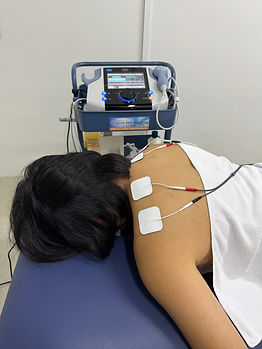Ultrasound, Electrotherapy and Dry Needling
The following are physiotherapy modalities that we typically use as part of managing symptoms like pain, stiffness, inflammation etc. They are typically used as adjuncts, on top of other physiotherapy interventions to improve symptoms for better performance or accelerate healing. Your physiotherapist will assess and advise accordingly.
-
Ultrasound therapy
The procedure is non-invasive and not painful. Patients typically feel a mild warm sensation over the treated area during the procedure.
-
Electrotherapy
Electrotherapy, like TENS and interferential current, reduces pain by blocking pain signals to the brain. It further increases the blood flow thus reducing the swelling and promoting the healing process. You will experience a sensation similar to ‘pins and needles’.
Common conditions treated with TENS:
-
Acute inflammation after injury
-
Back and neck pain
-
Muscle injury
Another form of Electrotherapy is NMES (Neuromuscular Electrical Stimulation). It is typically used for rehabilitation purposes after surgery to help the patient with the contraction of muscles, typically used in stroke rehabilitation and post-surgery rehabilitation. The aim of NMES is to help re-educate and strengthen dystrophied or weakened muscle(s) due to a neurological condition or surgical procedure.


-
Dry needling
Dry needling is an invasive procedure performed by a certified and trained professional that requires informed consent. More information on dry needling as follows.
What is Dry Needling?
Dry needling involves multiple advances of an acupuncture-type needle into the "trigger point" of the muscle. The aim is to achieve a twitch in the muscle, which is associated with reduced muscle tension and pain.
How does Dry Needling help?
Dry needling helps to reduce pressure on the nerve by releasing muscle tension. It is now well researched that the "twitch" response is associated with muscle relaxing and stopping the pull on adjacent areas.
What will I experience?
The needles used are very thin, you may or may not feel the needle enter your skin. If the muscle being needled is tight or sensitive, you may feel a "twitch" sensation. This is very short-lasting. Patients soon recognize this sensation as therapeutic as it is followed by a feeling of pain relief and muscle relaxation.
Are there any side effects?
The most common side effect is temporary muscle soreness after the treatment, typically lasting for a day or two. There are less common side effects such as bruising. If you have concerns about the side effects, please discuss with your clinician.
Are there any contraindications and precautions?
-
Pregnancy
-
Metal allergies
-
Implants
-
Axillary or inguinal node dissection
-
Joint replacements
-
Needle phobia
Please discuss with your clinician if there are further questions or concerns.
Is the procedure safe?
Yes, our physiotherapist has undergone formal training and certification (GEMt certified) to provide this treatment. We use GEMt dry needles. They are designed and manufactured for dry needling and are TGA approved.
How often will I need treatment?
Treatments are typically once a week, to allow enough recovery between sessions. The number of sessions will depend on:
-
How long you have had your problem
-
The extent of your problem
-
How quickly your body can heal
Informed consent is required prior this treatment. If it is your first time, you will be asked to sign an informed consent form to acknowledge your understanding and agreement for this treatment.
Contact us to book an appointment today.


Eg. Dry needling on deltoid for shoulder pain

Eg. Dry needling on low back muscle
_edited.jpg)